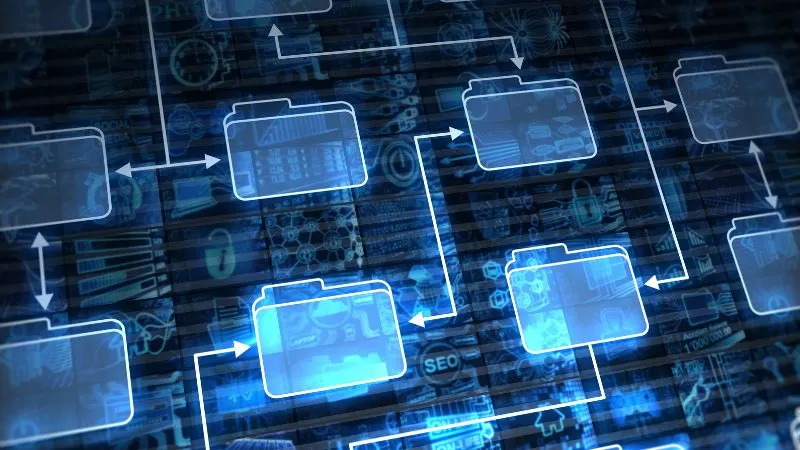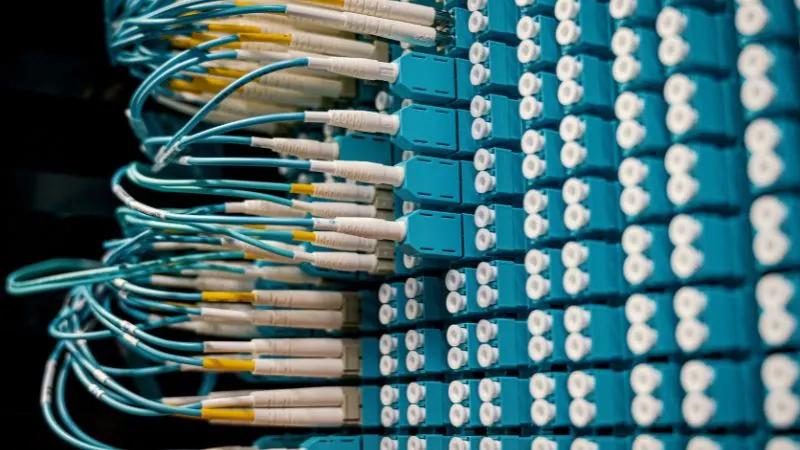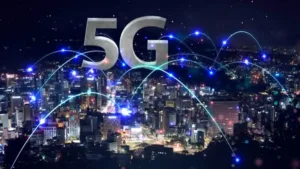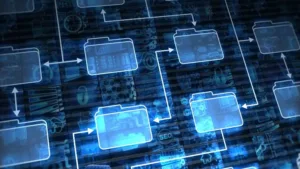Fiber optics is a revolutionary technology crucial for modern communication. At its core, it uses light signals to transmit data quickly and efficiently over long distances.
Basics of Optical Fiber Technology

Fiber optic technology relies on very thin strands of glass or plastic known as optical fibers. Each fiber is made up of a core, cladding, and a protective coating. Light signals are sent through the core, where they travel by bouncing off the cladding’s internal surface. This process is known as total internal reflection.
These light pulses carry data across vast distances with minimal loss. Unlike traditional copper wires that transmit electrical signals, fiber optics use light to ensure faster data speeds and less electromagnetic interference. This makes optical fibers an ideal choice for internet, cable, and telephone services.
Types of Fiber Optic Cables
You’ll come across two primary types of fiber optic cables: single-mode and multi-mode fibers.
Single-mode fibers have a small core and transmit light signals over long distances with minimal dispersion. They are ideal for telecommunications and long-distance data transfer.
Multi-mode fibers have a larger core and are used for shorter distances. They allow multiple light signals to travel simultaneously, making them suitable for data centers or local area networks. The difference in core size and application makes choosing the right type important depending on specific needs.
How Fiber Optic Cables Work

The Principle of Total Internal Reflection
Fiber optic cables rely on total internal reflection, which keeps light signals contained within the thin fibers. When light hits the fiber surface at a low angle, it doesn’t escape. Instead, it bounces off the walls of the fiber, traveling down the cable.
This process is efficient and allows data to move quickly. Photons, or light particles, zip back and forth without losing strength. This ensures that signals remain strong and clear, making fiber optics perfect for carrying data over long distances.
Core and Cladding: Understanding Refractive Index
Two main parts make up a fiber optic strand: the core and the cladding. The core is the path for light signals, while the cladding surrounds the core. These two layers have different refractive indexes or measures of how much they bend light.
The core has a higher refractive index than the cladding. This difference causes light to stay within the core. The index of refraction is crucial because it directs light along the fiber. Without it, the light would scatter, and signals wouldn’t reach their destination efficiently.
Advantages of Fiber Optic Communication

Benefits Over Copper and Coaxial Cables
Fiber optic cables offer notable advantages over copper and coaxial cables. These cables provide higher bandwidth, meaning they can handle more data at once. This is like upgrading from a narrow street to a multi-lane highway for data flow.
Electromagnetic interference is not an issue for fiber optics, making them more reliable in noisy environments. While copper wires can face disruptions, fiber optics remain stable. They are also lighter and more flexible, making installation easier.
Another benefit is that signals in fiber optics can travel over longer distances without the need for amplification. Copper cables, by contrast, require repeaters more frequently, which can increase costs and complexity.
Applications in Data Transmission and Telecommunications
Fiber optics provide high-speed broadband to homes and businesses. Faster internet means smoother video calls and quicker downloads for you.
In data centers, fiber optic networks form the backbone for fast and reliable data transmission. This enables seamless operations and supports cloud computing services. Telecommunications providers rely on fiber optics to ensure reliable communication networks, even over vast distances.
Challenges in Fiber Optic Systems
Signal Loss and Attenuation
Signal loss, or attenuation, is a big challenge in fiber optics. As light travels through the optical fiber, some energy is lost. This limits how far signals can travel without needing boosts.
Attenuation happens because of material imperfections and absorption by the fiber. Your choice of fiber type and quality affects loss rates significantly.
Chromatic Dispersion and Melting Point Considerations
Chromatic dispersion is another tricky issue. It occurs when different colors of light travel at different speeds. This can blur signals over long distances. Using single-mode fibers over multi-mode types helps reduce this effect. Choosing the right laser or LED source is also crucial.
Temperature can affect fiber optics. High heat can change the fiber’s melting point, leading to performance issues. Keeping cables away from heat sources helps maintain efficiency.
Real-World Uses of Fiber Optics
Fiber optics are crucial in many areas today, especially for internet access and medical advancements. They are widely used in providing high-speed internet connectivity and have significant applications in medical procedures like endoscopies.
Internet and Broadband Connections
Fiber optics play a huge role in internet services by allowing for fast data transmission. When you use fiber internet, you’re connected to the web at speeds much faster than traditional copper lines. This means activities like streaming videos, online gaming, or video conferencing are smoother and more reliable.
The way fiber optic cables work for your internet connection is fascinating. They send data through light pulses across tiny strands of glass or plastic, making them efficient for long distances without losing signal strength. This technology is increasingly popular because it supports high bandwidth, essential for modern internet services and computer networking.
Medical Innovations with Endoscopes
Fiber optics are also an important part of modern medicine, particularly in endoscopes like gastroscopes. These devices use thin, flexible cameras to explore inside the body. Fiber optics allow light transmission to illuminate areas being examined and carry back clear images to the medical team.
This technology is crucial for medical scanning and diagnostics, enabling non-invasive procedures that can be more comfortable for patients. Endoscopes equipped with fiber optics provide doctors a detailed view of areas that are hard to reach, improving the accuracy of diagnosing conditions inside the body. This advancement has significantly transformed patient care, allowing for precise and effective treatments.
Components of a Fiber Optic Network
In a fiber optic network, various components work together to transmit data as light signals. At the heart of this network are optical fibers. These thin strands of glass or plastic guide light signals over long distances with minimal loss.
Fiber-optic cables bundle these fibers together. They protect the fibers from damage and environmental factors. Inside a cable, you’ll find several layers of protection, including a buffer coating and an outer jacket.
A key component you’ll encounter is the transceiver. It acts as both a transmitter and receiver. Transceivers convert electrical signals to optical signals and vice versa, making sure your data travels smoothly through the network.
You also have fiber optic lines, which connect different parts of the network. They ensure data moves quickly and reliably from one point to another. These lines stretch across cities and even oceans, acting like superhighways for information.
Certain parts like splitters and couplers may also be used. These tools help direct, split, or combine light signals, allowing networks to manage and distribute data effectively.
The combination of these components ensures data moves at incredible speeds, making fiber optic networks a vital part of modern communication.
Frequently Asked Questions
Can you explain the role of optical fibers in data communication?
Optical fibers play a crucial role in data communication by allowing high-speed data transmission with minimal loss. They can carry large amounts of data across great distances, making them essential for both internet services and cable TV.
What are the uses of fiber optic cables in various applications?
Fiber optic cables are widely used in internet communication, cable television, and medical imaging. They are also employed in military and industrial applications where secure and fast data transfer is a priority.
Which types of signals are transmitted using fiber optics?
Fiber optics primarily transmit digital signals. They often carry internet data, phone signals, and television signals. The ability to send large amounts of data quickly makes fiber optics a preferred choice for long-distance communication.
What are the key advancements in the development of optical fiber technology?
Advancements include better fiber materials that reduce signal loss and increase speed. New technologies allow for higher data capacity, which helps support growing internet traffic and communication needs. These developments make fiber optics even more reliable and efficient.



